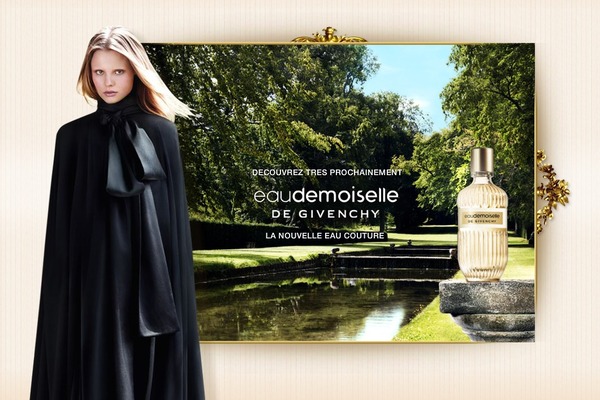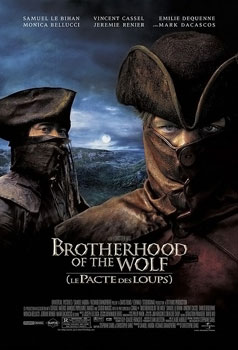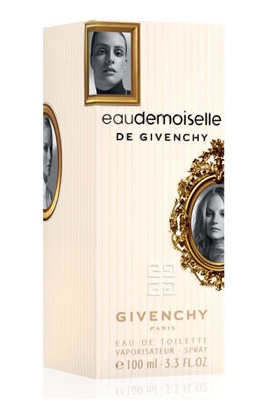Givenchy EauDemoiselle (2010): Looking for its Motto {Perfume Review & Musings}

Givenchy just released their new perfume EauDemoiselle, which after "reading" in-between the lines of the scent story seems to want to do for young women's skins and perfumed trails what Chanel is currently attempting to do for young women's lips this spring 2010, with Coco Rouge: offer them a rite-of-passage transition fragrance and lipstick to allow them to move on to classical heavier textures while stealing their attention away from kiddish perfumes and Lancôme Juicy gloss tubes, respectively.
The task in the case of EauDemoiselle is complicated by an advertising message selling aristocracy and the attempt to nail down what this age of innocence might smell like.
"Between tradition and modernity, eaudemoiselle de Givenchy is for a young woman of subtle sensuality and an affirmed personality, like this very personal scent, whose freshness already has the presence of a perfume."...
EauDemoiselle's Olfactory Personality
Notes: mandarin orange, Italian winter lemon, shiso (Japanese basil); absolute of Turkish rose, ylang ylang heart, orange blossom; crystalline musks, ambrette seed, tonka bean, cedar.
The eau de toilette is more particularly presented as a rose composition described as,
"The Delicate Grace of a Rebel Rose, an imaginary rose in the morning dew."
This is clearly the targeted spiel that this perfume brand and others offer phantasmal nubile women these days.
It's a rebel rose, as it turns out, destined to young women using their parents' credit cards, whose personalities are as of yet not well defined, but who might love the titillation of wearing a rebellious rose. I am not sure - yet I am sure that the brand itself is not sure either - that these abstract young women exist anywhere, except in people's imaginations. But let's pretend that they do shop for perfume looking for thorny anti-conformist roses or more assuredly, an assurance that they will get branded as roses that can prickle blood out of your fingers. Flattery will get you anywhere, apparently.
My advice meanwhile: wear Nahema instead, which may not be officially "a rebel rose" but is not behaving like everyone else's rose.
I am willing to some extent to accept the brand's characterization of EauDemoiselle as a rose bathed in dew as the composition is quite watery but it is not such a characteristic rose perfume as could be expected. Givenchy in all fairness does stress the abstract style of the perfume. The fragrance strikes me more however at first as a classic white floral scent sweetened by orange blossom, discreetly powdery iris and an almondy nuance (tonka bean). Rather than making me think of abstraction, it makes me think of an extremely predictable white floral bouquet combining jasmin, rose, tuberose, ylang, to the point where it smells more of a base than a perfume accord. A common thread runs for example in Guerlain Jardins de Bagatelle, Number One by Parfums de Nicolaï or Micallef Watch, but made more watery and sweetish in EauDemoiselle.
I am struck by how difficult it is to pin down the personality of EauDemoiselle, this meant not in a favorable manner. A gentle rose with pencil shavings or cedar wood nuances emerges from the fresh, undefined sweetness.
It all feels rather generic, like a wet rendition of an honest, tolerable but certainly not exceptional aristocratic rose perfume, which I would interpret in principle to mean that it ought to smell of something like a rose scent wafting down the streets of the city of St Petersburg, Russia, and espousing its contours on a clear early morning, when the architecture is pristine and the perspectives clear and well-designed.
Saving Grace, Barely
The moment of saving grace appears at last when some discreet, sharper citrusy nuances come to enliven the rather bland concoction, so far. I am then reminded that the composition features a shiso note. This is the first time in the development that the perfume appears more like a 3-D composition, with more volume, definition and a sense of contour, and not just a 2-D blend out of a cocktail shaker.
As the composition progresses, the green citrusy and leafy nuances of shiso come to define the perfume more. But the floral bouquet itself is extremely conventional, like a white wedding bouquet ordered at a chain store.
The concoction then warms up with vanilla fortunately still cut through by the saving grace of the more defined note of shiso.
The Context
An obvious point of comparison for me is to think of the Infusion series by Prada which are similarly lighter fragrances incorporating a nod to the eau de cologne genre,
Perfumer Daniela Andrier compares them as having the same ephemeral quality as foot marks left in the wet sand.
Another obvious parallel is to be made with the Miss Dior Eau which has been good to the Dior portfolio held by LVMH. Givenchy and Dior are both under the purview of perfumer François Demachy, who is the signature on EauDemoiselle (think team effort).
The shiso note also makes me think of Annick Goutal Matin d'Orage, which introduced it combined with a white floral note of gardenia.
For me, there is a perfumery which is mainly creative and will offer unusual, well-thought out accords - and then, there is a perfumery which is more conservative yet offers subtle, interesting delicate nuances. There is also a perfumery which is neither and is simply masterful, able to create a beautiful synthesis based on a perception of nature, intelligence and emotion. There is professional, efficient perfumery.There are many different sorts of perfumery philosophies and inspirations.
I am at a loss to identify what EauDemoiselle concretely does beyond its purported mission of being a transition, rite-of-passage perfume and ultimately smelling rather good. The rather derogatory French expression sent-bon applies aptly to it. This means that it smells good, but that there is not an iota of spirit, or wit in it.
EauDemoiselle in this manner starts like an uninspired bouquet, caving in to all the most pedestrian trends. It then meets the shiso note which comes to regenerate the tired refrain of the classic white floral. Finally it manages to blend in more harmoniously and pleasantly, with more conviction, and a little bit more gusto.
Some perfumers say that it is not easy for them to create watery compositions and it may well be the case that there was a mismatch of talents in this case. At any rate, I cannot help but think of the first stage of the development of the perfume as Europe-before-the-spice-trade: it smells bland. A merchant introduces shiso: good. The synthesis with the South American vanilla and tonka bean spices brought over by another merchant makes things finally a bit more interesting.
EauDemoiselles makes you shudder at the thought of what life would be without spices. It would smell like the clear floral broth that it is for a good initial part of it,
The Selling Point of the Aristocracy
The aristocratic thematic of the advertising campaign is worth addressing as it is not often that the concept is put forth in commercial perfumery. Perfumery is a descendant of, first, a religious, then a courtly tradition, so there is in filigree at least a permanent reference to courtly and by extension aristocratic ideals.  In the case of EauDemoiselle this reference is made explicit and put front and center, which makes it stand out for its distinctive approach. This was explained by the brand as a historical reference to the founder of the house, Hubert de Givenchy and the name of its debut fragrance Le De which is a direct allusion to his particule or title.
In the case of EauDemoiselle this reference is made explicit and put front and center, which makes it stand out for its distinctive approach. This was explained by the brand as a historical reference to the founder of the house, Hubert de Givenchy and the name of its debut fragrance Le De which is a direct allusion to his particule or title.
The advertising for EauDemoiselle features Magdalena Frackowiak wearing a black cape designed by Ricardo Tisci. The aristocracy of the character portrayed in the image is signaled by the unconventional, atemporal style of the outfit - its presence as an ostentatious piece of clothing but which at the same time is restrained in its effect of color and richness and as far removed from the vulgarity of bling as could be. There is a little bit of the kind of cape-and-dagger moody and dark aristocratic atmosphere as depicted in the French movie Le pacte des loups (Brotherhood of the Woolf), with at one point its message of pathological in-bred exclusivity exemplified in one of the characters, who logically pushes the idea to its limits by revealing himself to be incestuous. Chateaubriand's feelings for his sister seems to be a model.  Am I far too far off the signs that this bottle of perfume wants to project? I would argue that there is a modicum of that in EauDemoiselle. I find it interesting that at a lighter level this notion of internal exclusivity is recreated by the use of Givenchy own PR staff faces on the packaging of the bottle. The perfume brand instinctively understands that it coheres with its aristocratic thematic to allude to an in-group, an exclusive family of sorts.
Am I far too far off the signs that this bottle of perfume wants to project? I would argue that there is a modicum of that in EauDemoiselle. I find it interesting that at a lighter level this notion of internal exclusivity is recreated by the use of Givenchy own PR staff faces on the packaging of the bottle. The perfume brand instinctively understands that it coheres with its aristocratic thematic to allude to an in-group, an exclusive family of sorts.
All this would be well and fine if the perfume, the jus, let you not perceive a discrepancy between these semiotics of privilege and blue blood which are used to signal high quality - and the smell itself.
Like an ultimate privilege of misguided arrogance, the scent itself seems to want to express the fact that it does not need to smell that meritorious to retain our attention.
EauDemoiselle could have been the best of both worlds: a mix of refined gentility and youthful creativity, but in the end it resorts more to discourse and imagery than to full-blooded realization.









